Fancy porcelain bathtubs are an undying trend in interior design. Fair enough, a new shiny bathtub is eternally appealing.
But one day, you’ll notice dirty marks that are not so easy to eliminate. You’ll very soon understand that the price for all that appeal is more than just the dollars you spent on it.
Taking care of porcelain tubs can be a little scary, but with some tips, it will take less time and mental capacity. As a result, you’ll have a nice clean tub, and maybe you’ll feel like soaking in it with a glass of wine.
So, stay here and learn the tips that will make your porcelain bathtub shine again!
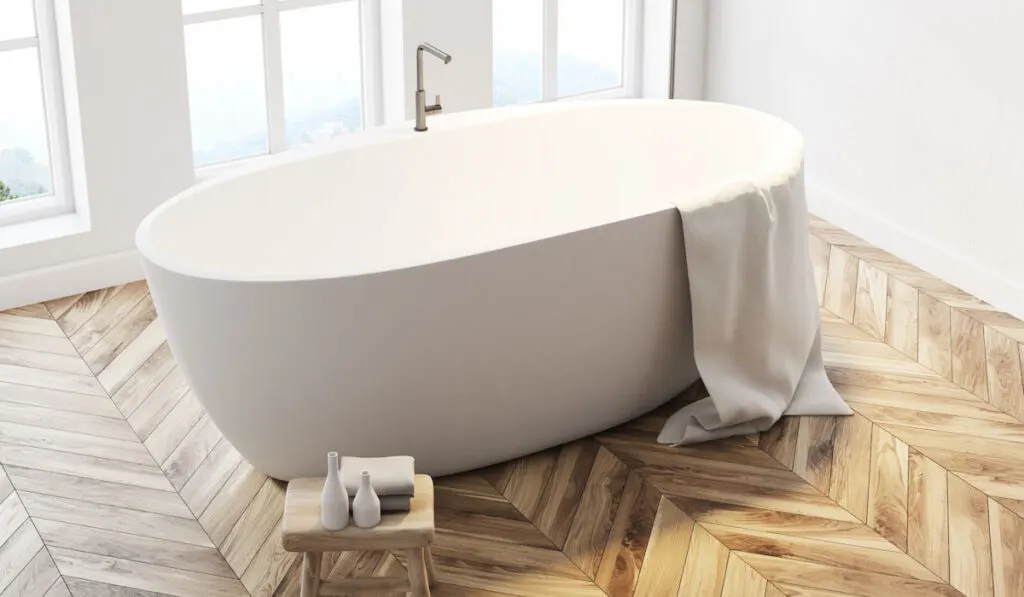
Table of Contents
How to Figure Out if Your Bathtub Is Porcelain
But before we start…how do you know your bathtub is porcelain?
Let’s say you have received the bathtub as an inheritance from your grandparents, or you’re just not so knowledgeable about surfaces and materials, which is completely OK.
Today, many household bathtubs are enamel – they are inexpensive and light, meaning less trouble carrying or installing them.
If you want to check which material your bathtub is made of, do a sound check: Knock on your bathtub lightly, and if what you hear sounds metallic, then the bathtub is enamel.
Another way to check the material is by using a magnet. Because enamel bathtubs are metal underneath, magnets will stick to them.
It’s easy to confuse enamel and porcelain. But as we’ve said, enamel is quite light, unlike porcelain.
Porcelain is pretty heavy and thus is not as popular as enamel or acrylic.
By the way, acrylic bathtubs look like they’re made of plastic, so you’re less likely to confuse them with porcelain.
Don’t use abrasive materials with acrylic and enamel surfaces as they are prone to scratches and acid marks (so no vinegar or bleach).
Porcelain surfaces are slightly resistant to the above liquids, but it doesn’t mean you can be careless about them. In fact, they have their own rules for the game.
So, now that you’re familiar with the ways to tell apart the most common bathtub materials, let’s look at how to clean our queen of the show – porcelain.
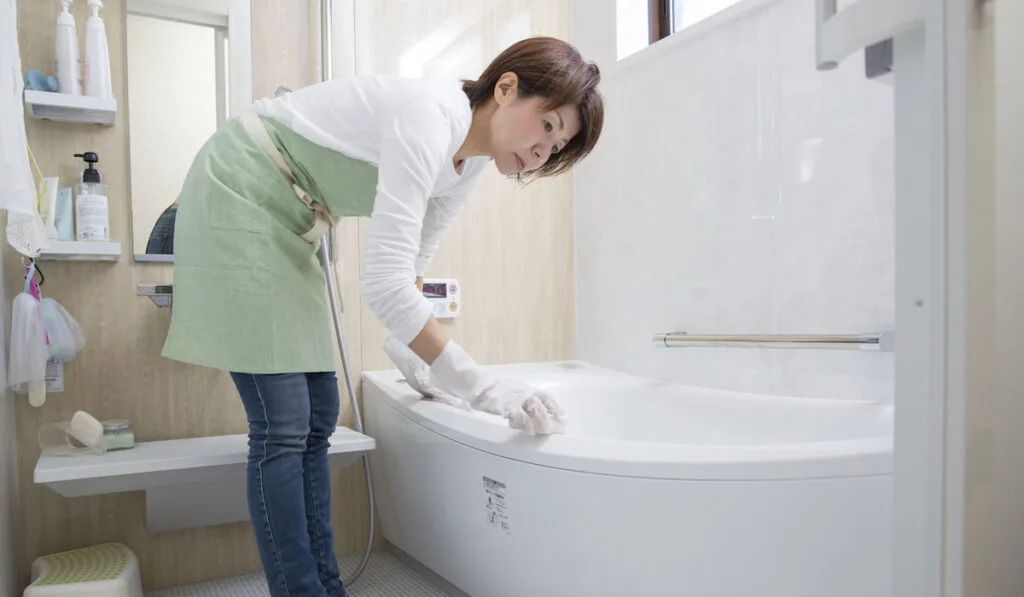
What Materials to Avoid
We’ve mentioned some of the materials you should not use with enamel and acrylic surfaces. When it comes to porcelain, the list is actually the same.
In short, these abrasive cleaners and materials are prohibited:
- White vinegar
- Scouring powder
- Steel wool
Instead, take notes below on items you’ll need when cleaning the porcelain bathtub.
What Materials to Use
Before we give you the list, it’s important to note that the most effective way to keep porcelain surfaces clean is to wash them regularly.
Still, not all of us are such clean freaks, right? For cases like that (and also for some deep stains), you’ll need one deep cleaning session once in a while.
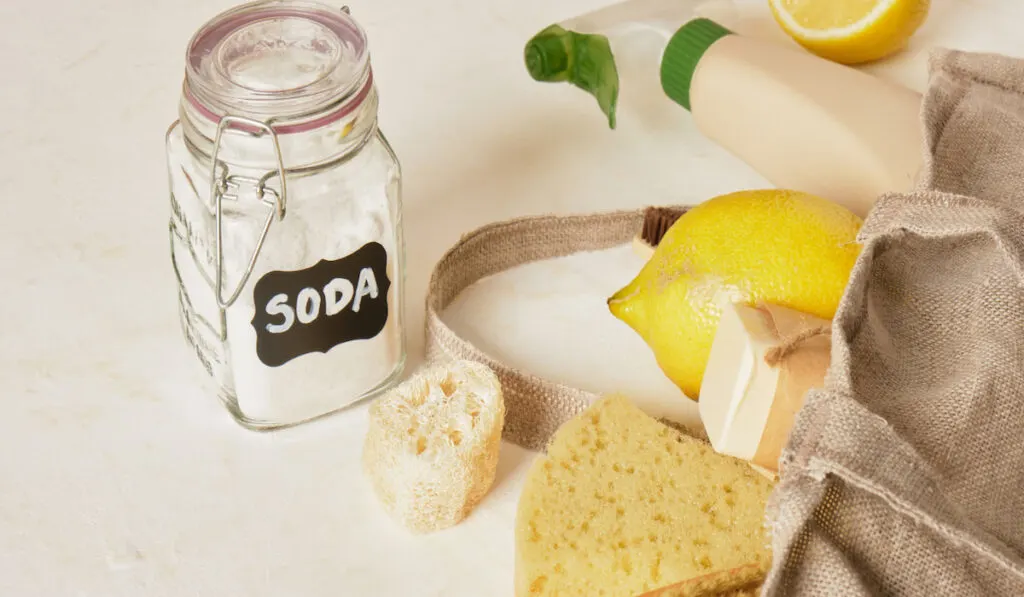
There are a few essential items you’ll need if you have a porcelain bathtub:
- A bucket
- Warm water
- Dishwashing soap
- Baking soda
- Ammonia
- A non-abrasive nylon sponge or cloth
- Fresh lemons and salt (in case of horrible stains)
For your information, some sources do recommend spraying a mixture of white vinegar and water, or bleach and water, for porcelain.
It is important to note that these methods are recommended when your bathtub is extremely, unforgivably stained. (Sometimes, we get our bathtubs from really curious places…)
As for the rest of you, let’s look at how to clean “regular” porcelain bathtubs.
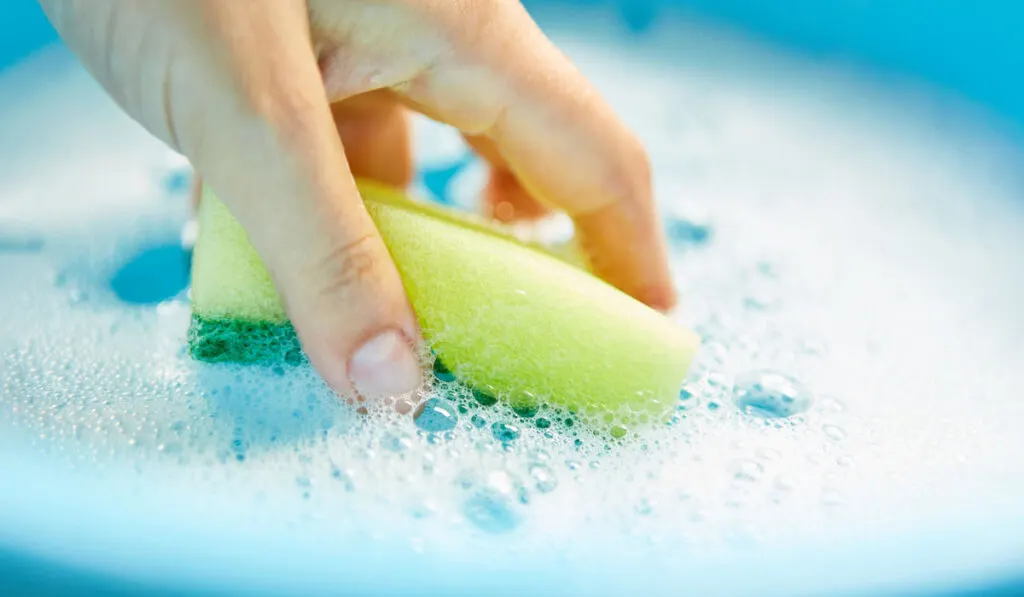
Tip #1: Regular Porcelain Bathtub Cleaning
Cleaning porcelain bathtubs once a week will save you lots of dead nerve cells and time, so it’s better to make it a habit.
To do a weekly cleaning most efficiently, follow the instructions below:
- Prepare a mixture of 1 gallon of hot water and two tablespoons of dishwashing soap (or any grease dissolving liquid).
- Take a soft cloth or nylon sponge, dip it into the mixture and scrub the bathtub gently.
- When the week-old stains are gone, and the bathtub is clean, rinse it well.
Done! Your porcelain bathtub is squeaky clean!
But what if your stains are older than one week? No problem, let’s move to the next level.
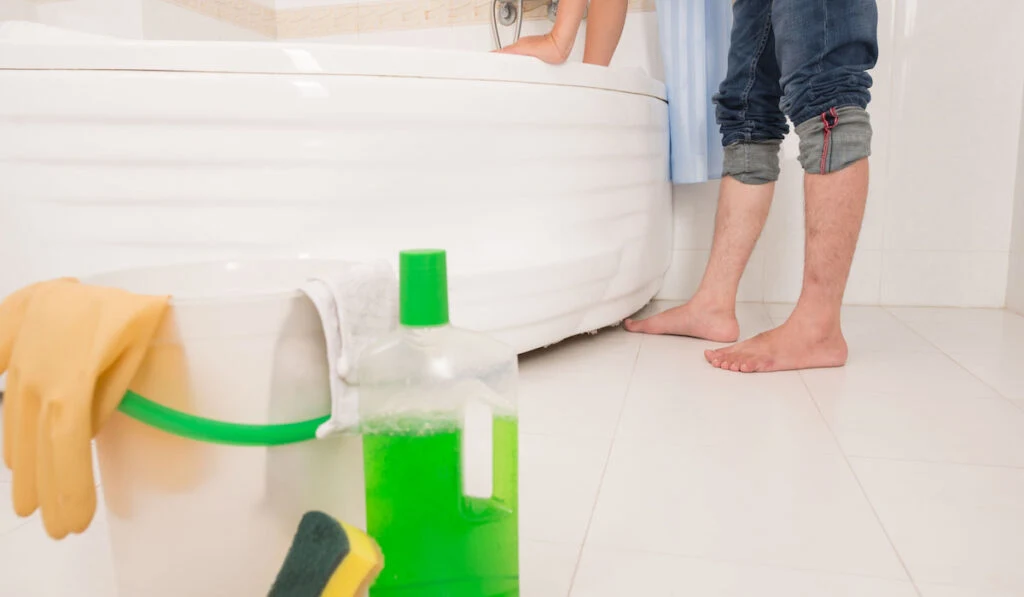
Tip #2: Deep-Cleaning the Porcelain Bathtub
Try this strategy if your bathtub has really tough stains that don’t go away with scrubbing:
- Fill a bucket with warm water and add 1/4 cup ammonia and 1/4 cup baking soda.
- Take a sponge or cloth and soak it in the mixture.
- Scrub the bathtub gently, focusing on the tough stains. Repeat the action until the tub is clean.
- Rinse it well.
- Wipe the surface well with a clean rag to prevent the baking soda from leaving a white film behind.
Deep-clean the porcelain surface once or twice a month, depending on the level of dirtiness.
However, what if this method also doesn’t work?
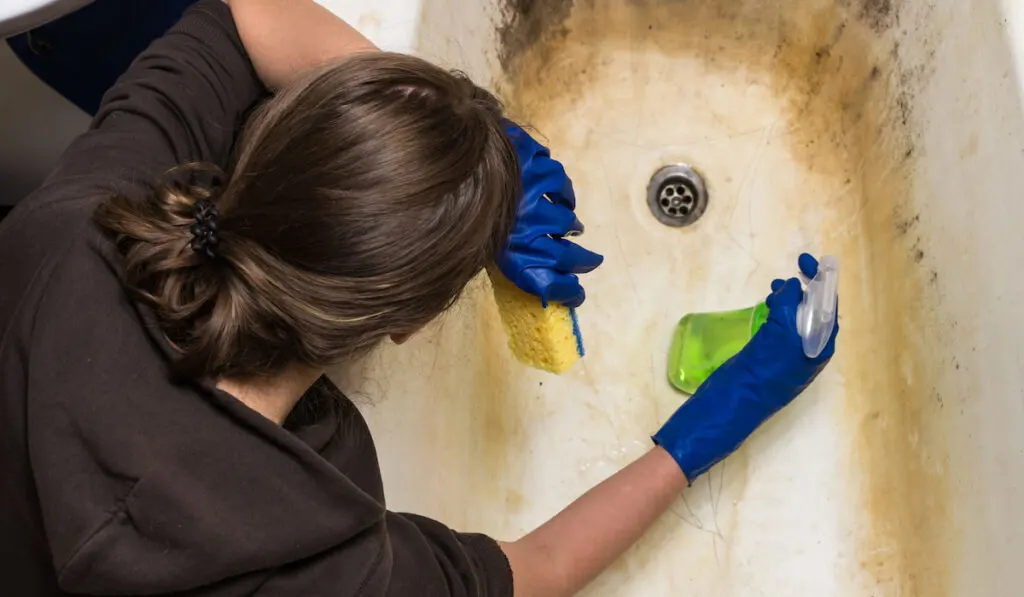
Tip #3: Cleaning Tough Stains: Second Try
If the stains are as tough as the porcelain itself, here’s the “Final Boss” method.
Put salt on the most stained places and squeeze the lemon juice (half a lemon) on top of it. Leave the mixture for 30 minutes or an hour (just to make sure).
A big hint: Salt and lemon juice are pretty good if you’ve found rust spots on your porcelain tub.
But if this method doesn’t work, there’s no other way but to call for professional help.
Reglazing services are quite popular and provide high-quality work, after which your porcelain bathtub will shine like new.
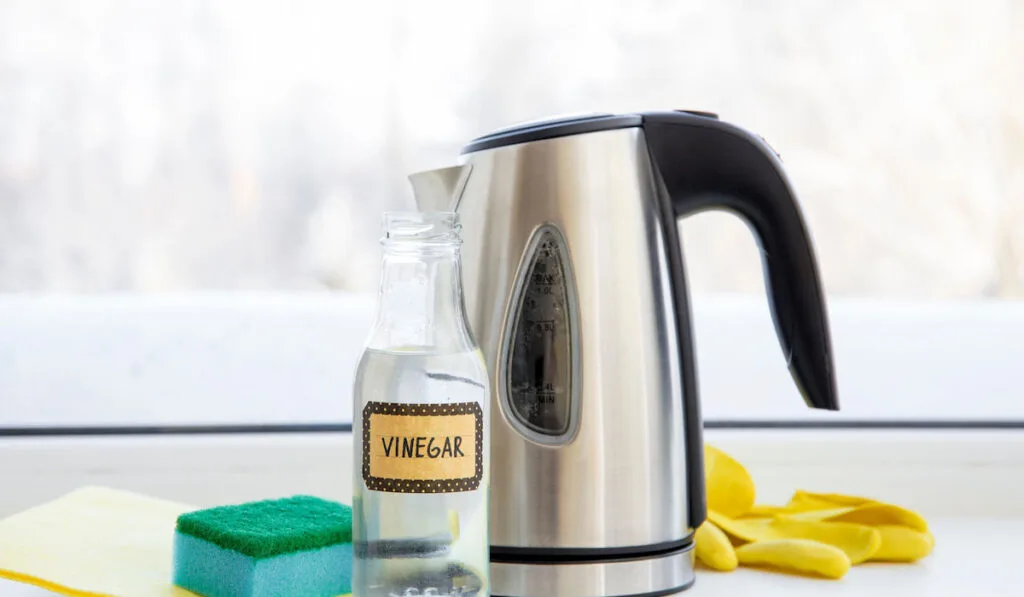
Tip #4: What about Vinegar or Bleach, Though?
Remember we mentioned that extra method? The one you can use at your own risk?
Have little advice here: If you do try cleaning your porcelain bathtub with vinegar, test it on a small, nonvisible section before cleaning the entire tub.
Now let’s go to the potion part:
- Mix water and vinegar, following a 1:1 ratio. You can also add a teaspoon of lemon juice for extra scent.
- Spray the bathtub with the mixture and leave it on the surface for 15-20 minutes.
- Scrub the surface gently with a damp cloth or a sponge. Start at the top and slowly move to the bottom so the soap scum and dirt will run into the tub.
If the bathtub is hopelessly stained, try this method:
- Make a solution of hot water, ½ – 1 gallon of vinegar, and 1-2 cups of baking soda, and leave it for 30 minutes or an hour.
- Drain the bathtub and scrub the stains until the tub is clean.
If you decide to use bleach, here’s the recipe (don’t forget to wear a face mask or respirator and cleaning gloves or even safety glasses):
- Prepare a solution of 1 gallon of water and ½ cup of bleach.
- Coat the bathtub’s surface using a sponge and wait for 5 minutes.
- Scrub the surface, focusing on severe stains.
- Rinse the bathtub with cold water, and be careful not to splash the bleach for your safety.

Protect the Shining Tub
So, you’re finally successful. Your bathtub is shining and clean, just like the first time you used it. Why not add a finishing touch to make it sparkle?
You can add a protective coating using lemon oil.
The best thing about lemon oil is its dirt-repelling features. This way, your tub will stay clean for longer. Did we mention it will smell good as well?
Just squeeze a small amount of lemon oil on a clean rag, and then rub it into the sides of the bathtub (rubbing is essential).
Avoid using oil on the bottom of the bathtub so you don’t slip and traumatize yourself.
In Summation:
Cleaning a porcelain bathtub may have seemed to you as a mission impossible. But now that you’re equipped with new knowledge, nothing is holding you back from a relaxing bath. You deserve it.
Resources:
- https://www.merrymaids.com/cleaning-tips/quick-tips/fight-back-against-your-bathtub-stains/
- https://www.modernbathroom.com/blog/post/2018/02/13/guide-to-cleaning-a-porcelain-tub
- https://www.apartmenttherapy.com/how-to-clean-an-old-porcelain-enamel-bathtub-or-sink
- https://www.thisoldhouse.com/cleaning/22331616 /deep-clean-a-bathtub
